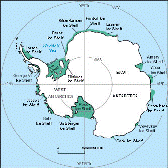Antarctic Drilling Program (ANDRILL)

ANDRILL Related Publications of Affiliates
Document Type
Article
Date of this Version
2007
Abstract
An apparent mismatch between published oxygen isotope data and other paleoclimate proxies for the span from 26-16 Ma is resolved by calibration against eustatic estimates obtained from backstripped continental margin stratigraphy. Ice-volume estimates from calibrated oxygen isotope data compare favorably with stratigraphic and palynological data from Antarctica, and with estimates of atmospheric carbon dioxide for the early Oligocene through early Miocene (34-16 Ma). These isotopic data suggest that the East Antarctic Ice Sheet grew to as much as 30% greater than the present-day ice volume at glacial maxima. This conclusion is corroborated by seismic reflection and stratigraphic data from the Antarctic margin that suggest that the ice sheet may have covered much of the continental shelf at Oligocene and early Miocene glacial maxima. Palynological data suggest long-term cooling during the Oligocene, with near tundra environments developing along the coast at glacial minima by the late Oligocene.


Comments
Citiation: Pekar, S.F., N. Christie-Blick (2007), Showing a strong link between climatic and pCO2 changes: resolving discrepancies between oceanographic and Antarctic climate records during the Oligocene and early Miocene (34-16 Ma), in Antarctica: A Keystone in a Changing World – Online Proceedings of the 10th ISAES, edited by A.K. Cooper and C.R. Raymond et al., USGS Open-FileReport 2007-1047, Extended Abstract 024, 4 p.